Aerial photography offers you a unique perspective on urban design, disclosing hidden architectural gems you can't see from the ground. From rooftop gardens to forgotten facades, sky-high views reveal intricate patterns, symmetry, and geometric shapes in buildings and cityscapes. You'll discover historical structures nestled among modern developments, and witness how urban planning shapes our environment. Drones and helicopters provide unprecedented access to these elevated vantage points, showcasing the interplay of light, shadow, and texture across architectural marvels. By exploring cities from above, you'll gain a new appreciation for the artistry and complexity of our built environment. The secrets of urban landscapes await your exploration.
Aerial Perspectives on Urban Design

In recent years, aerial photography has revolutionized our understanding of urban design. From high above, you'll see patterns and structures that aren't visible from the ground, revealing the true scale and interconnectedness of our cities. Drones and helicopters now offer unprecedented access to these bird's-eye views, allowing you to capture stunning images of architectural masterpieces and urban planning marvels.
As you explore aerial photography, you'll notice how different cities have unique layouts. Some follow rigid grid systems, while others have organic, winding streets. You'll spot hidden courtyards, rooftop gardens, and intricate building designs that often go unnoticed at street level.
These aerial shots also highlight the contrast between old and new neighborhoods, showcasing how cities evolve over time.
To get the best aerial shots, you'll need to take into account lighting conditions, weather, and time of day. Early morning or late afternoon often provide the most dramatic shadows and colors.
Don't forget to pay attention to composition – leading lines, symmetry, and patterns are especially striking from above. With practice, you'll develop an eye for capturing the essence of urban design from this unique perspective.
Rooftop Gardens and Green Spaces
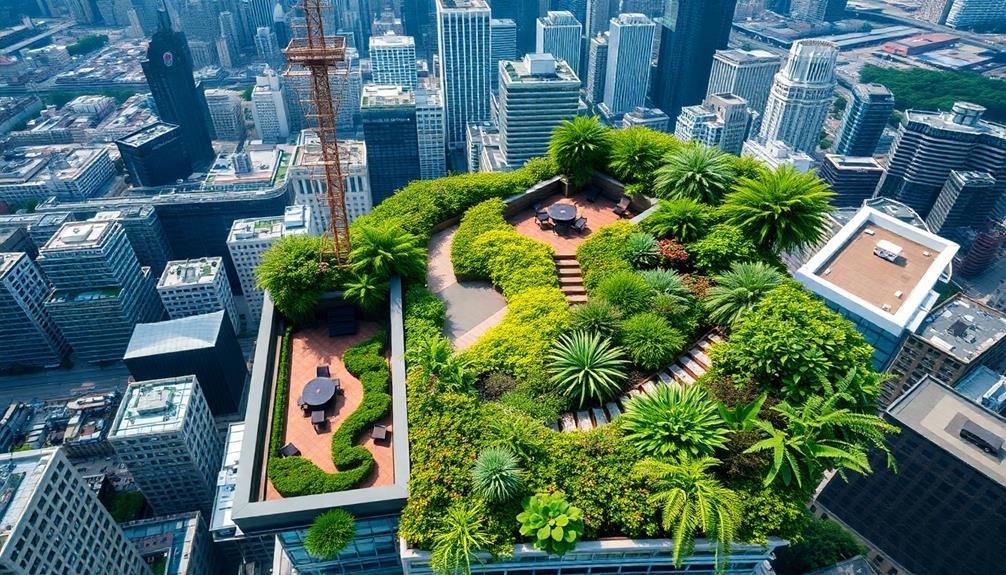
While aerial views offer a broad perspective of urban design, zooming in on rooftop gardens and green spaces reveals a growing trend in sustainable architecture.
You'll notice these elevated oases dotting city skylines, providing a rejuvenating contrast to concrete and steel structures.
As you focus your lens on these sky-high gardens, you'll capture the intricate layouts of plant beds, seating areas, and even small water features.
Look for the interplay of textures between foliage and building materials, creating visually striking compositions.
You might spot urban beehives or vegetable gardens, showcasing the multifunctional nature of these spaces.
Don't overlook the human element in your shots.
Capture people enjoying these green retreats, whether they're relaxing, gardening, or holding meetings.
These images tell a story of how rooftop gardens are transforming urban living and working environments.
Pay attention to the environmental impact these spaces have.
You'll often see solar panels alongside plants, demonstrating a holistic approach to sustainability.
Forgotten Facades Rediscovered From Above
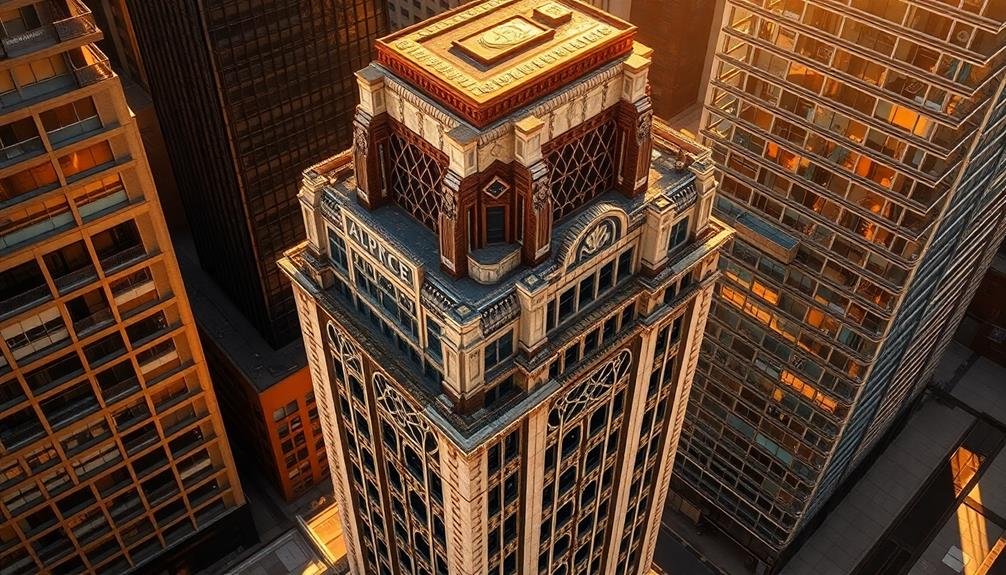
You'll discover a whole new world of architectural beauty when you look at buildings from above.
Aerial photography uncovers forgotten facades and overlooked details that aren't visible from street level. This unique perspective can reveal intricate rooftop designs, hidden courtyards, and symmetrical patterns that breathe new life into familiar structures.
Aerial Perspective Reveals Beauty
Architectural treasures often hide in plain sight, waiting to be rediscovered from a new vantage point. With aerial photography, you'll reveal a world of hidden beauty in urban landscapes. From above, you'll see intricate roof designs, symmetrical layouts, and harmonious cityscapes that aren't visible from the ground.
As you explore cities from the sky, you'll notice how buildings interact with their surroundings. Parks become green oases amidst concrete jungles, while rivers snake through urban centers, revealing the city's relationship with nature. You'll also spot forgotten courtyards, rooftop gardens, and architectural details that have eluded pedestrians for years.
| Perspective | Ground View | Aerial View |
|---|---|---|
| Scale | Limited | Expansive |
| Details | Close-up | Patterns |
| Context | Isolated | Integrated |
Aerial photography doesn't just capture individual buildings; it reveals the urban fabric as a whole. You'll discover how different architectural styles blend together, creating a unique visual narrative of the city's history and development. This bird's-eye view also highlights urban planning decisions, showcasing the city's growth patterns and the impact of design choices on the overall urban landscape.
Overlooked Details From Above
From the bird's-eye view, we can now zoom in on the often-overlooked details that make buildings truly unique.
You'll discover hidden gems that aren't visible from street level, revealing the intricate craftsmanship and design elements that architects have carefully incorporated into their creations. Rooftop gardens, ornate cornices, and elaborate weathervanes suddenly come into focus, offering a fresh perspective on familiar structures.
As you explore these forgotten facades from above, you'll gain a newfound appreciation for the thought and artistry that goes into every aspect of architectural design.
Here are four key elements you're likely to notice:
- Intricate tile patterns on rooftops
- Symmetrical arrangements of skylights and chimneys
- Hidden sculptures or gargoyles perched on ledges
- Geometric shapes formed by rooflines and terraces
These aerial insights not only showcase the beauty of individual buildings but also reveal how they fit into the larger urban landscape.
You'll see how architects have carefully considered the visual impact of their designs from all angles, creating a harmonious blend of form and function that's best appreciated from above.
Symmetry in Skyline Silhouettes

Look out over the skyline of any major city, and you'll notice a fascinating symmetry in its silhouette. This architectural harmony isn't accidental; it's often the result of careful urban planning and design.
As a photographer, you can capture this balance by positioning yourself strategically and using the right lens. To highlight skyline symmetry, try shooting from elevated vantage points. Rooftops, hills, or neighboring tall buildings can offer perfect perspectives.
Use a wide-angle lens to encompass the entire cityscape, ensuring you're centered on the most visually balanced section. Pay attention to the golden hour or blue hour for dramatic lighting that accentuates building shapes.
Look for natural or man-made features that create mirror-like effects. Rivers, lakes, or even wet streets after rain can provide reflections that double the symmetry.
Don't overlook the power of negative space; sometimes, the sky itself can frame buildings in a symmetrical composition. When editing, consider using the rule of thirds or central composition to emphasize balance.
Subtle adjustments to straighten horizons and align vertical lines can greatly enhance the perception of symmetry in your skyline shots.
Capturing Intricate Architectural Patterns
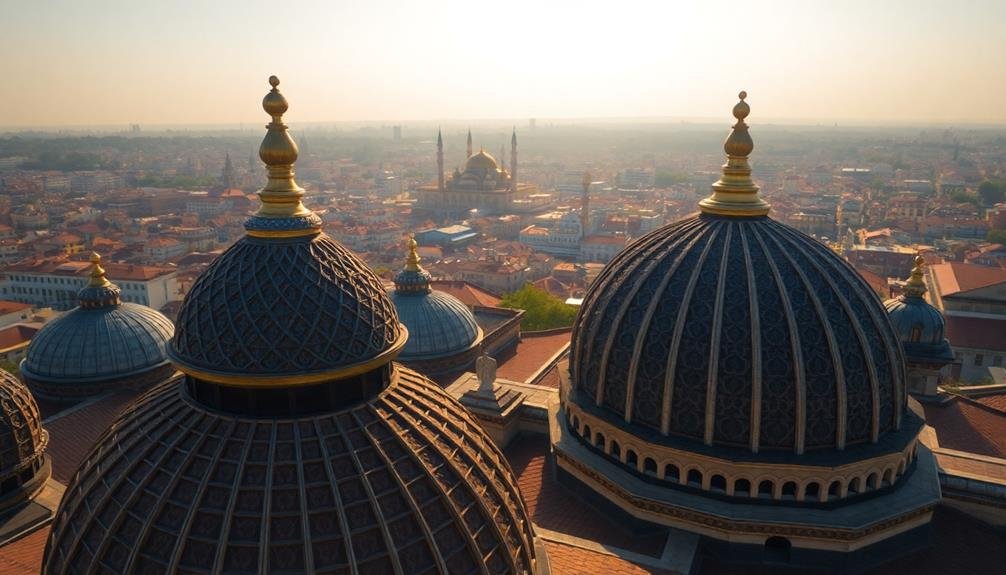
When you're capturing intricate architectural patterns, don't overlook the power of symmetry in aerial shots.
You'll find that textures from above can reveal unexpected details and patterns not visible from ground level.
As you explore these elevated perspectives, you'll often uncover striking geometric shapes that add depth and interest to your architectural photography.
Symmetry in Aerial Shots
Aerial photography's unique vantage point reveals the hidden symmetry and intricate patterns of architectural marvels. As you soar above cities and structures, you'll discover a world of geometric precision that's often invisible from the ground.
Symmetry in aerial shots can transform ordinary buildings into enchanting works of art, highlighting the architect's vision and the harmony of design.
To capture stunning symmetrical aerial shots, consider these tips:
- Look for buildings with repetitive elements
- Align your camera perpendicular to the subject
- Use gridlines to guarantee perfect symmetry
- Experiment with different altitudes for varied perspectives
You'll find that symmetry isn't limited to individual buildings. Entire city blocks, parks, and even neighborhoods can exhibit mesmerizing patterns when viewed from above.
As you frame your shots, pay attention to how light and shadow play across the structures, enhancing the symmetrical effect. Don't be afraid to crop your images in post-processing to perfect the symmetry and draw the viewer's eye to the most striking elements.
With practice, you'll develop an eye for spotting and capturing these hidden architectural gems from the sky.
Textures From Above
Textures take on a whole new dimension when viewed from above. As you capture architectural patterns from the sky, you'll discover intricate details that often go unnoticed at ground level. Rooftops, courtyards, and building facades reveal their true complexity when photographed from a bird's-eye perspective.
When shooting textures from above, pay attention to repetitive elements like tiles, brickwork, or geometric designs. These patterns can create mesmerizing compositions that draw the viewer's eye across the frame. You'll want to experiment with different altitudes to find the sweet spot where textures are most prominent.
Lighting plays an essential role in emphasizing textures. Early morning or late afternoon sun casts long shadows, accentuating the depth and dimensionality of architectural features. Overcast days can also work in your favor, providing even illumination that highlights subtle textures without harsh contrasts.
Don't forget to reflect on the interplay between different materials. The juxtaposition of smooth glass surfaces against rough stone or the contrast between modern and historic building textures can create visually striking images.
Geometric Shapes Revealed
Architecture's hidden geometry comes to life through the lens of a camera. As you explore buildings from above, you'll discover intricate patterns and shapes that often go unnoticed from ground level. These geometric forms aren't just aesthetically pleasing; they're fundamental to a structure's design and functionality.
When capturing architectural geometry from above, you'll want to:
- Look for symmetry in building layouts
- Identify repeating patterns in roof structures
- Focus on the interplay of light and shadow
- Capture the contrast between organic and man-made shapes
You'll find that different architectural styles reveal unique geometric signatures. Modern buildings often showcase clean lines and stark angles, while historical structures may feature more ornate, radial patterns.
As you frame your shots, pay attention to how these shapes interact with their surroundings. The negative space between buildings can be just as compelling as the structures themselves.
Don't forget to experiment with different times of day. Early morning or late afternoon light can cast long shadows, emphasizing the building's geometry and creating dramatic contrasts.
Light and Shadow Play
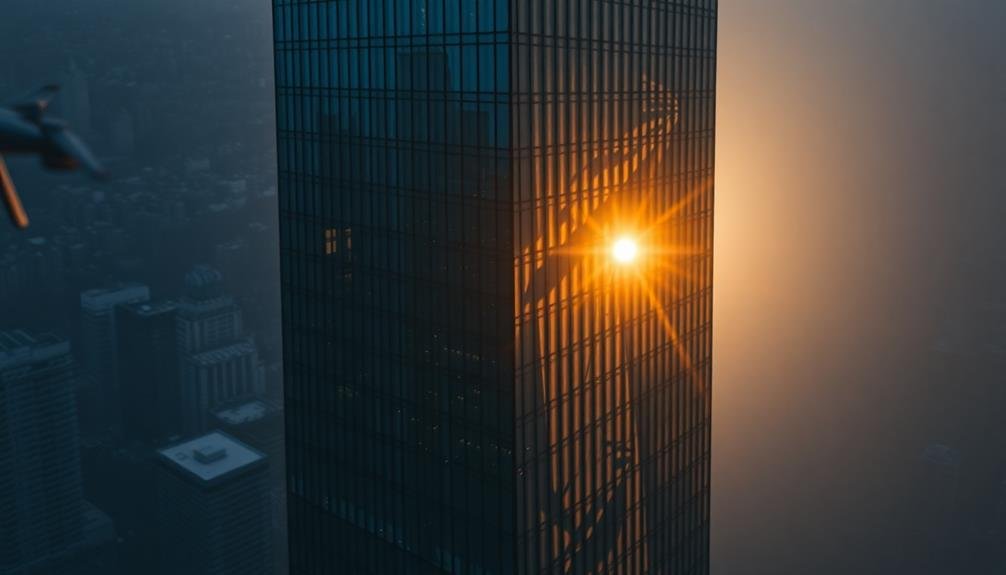
Mastery of light and shadow is essential in architectural photography. You'll find that these elements can dramatically transform a building's appearance, highlighting its unique features and creating depth. As you capture architectural gems, pay attention to how sunlight interacts with different surfaces and structures throughout the day.
To enhance your shots, consider the following techniques:
| Time of Day | Light Quality | Shadow Effect |
|---|---|---|
| Dawn | Soft, warm | Long, dramatic |
| Midday | Harsh, bright | Minimal |
| Golden Hour | Rich, golden | Soft, defined |
| Dusk | Cool, diffused | Subtle, fading |
| Night | Artificial | High contrast |
Experiment with different angles and perspectives to maximize the impact of light and shadow. You might find that shooting from below accentuates a building's height, while side-lighting can emphasize texture and form. Don't shy away from challenging lighting conditions; they often lead to the most striking images.
Historical Buildings in Modern Context

When photographing historical buildings, you'll often find opportunities to capture the interplay between old and new architecture.
You can highlight this contrast by framing a centuries-old structure against a backdrop of modern skyscrapers or juxtaposing traditional materials with contemporary glass and steel.
Additionally, consider exploring adaptive reuse projects, where historical buildings have been repurposed for modern use, offering unique perspectives on the blending of architectural eras.
Contrasting Old and New
Three striking contrasts emerge when capturing historical buildings in a modern context. You'll notice the juxtaposition of architectural styles, materials, and scale. Old structures often feature intricate details and craftsmanship, while modern buildings boast sleek lines and minimalist designs. This visual interplay creates enthralling compositions that tell a story of urban evolution.
When photographing these contrasts, you'll want to focus on:
- Light and shadow: Use natural light to highlight the textures of old buildings against the reflective surfaces of new ones.
- Framing: Position historical elements in the foreground with modern skylines as a backdrop.
- Perspective: Experiment with low angles to emphasize the grandeur of older structures.
- Time of day: Capture twilight shots to showcase the warm glow of heritage buildings against illuminated contemporary facades.
You'll find that color plays an essential role in emphasizing the contrast. The weathered patina of aged stone and brick often stands out against the cool tones of glass and steel.
Don't shy away from including people in your shots; they add scale and bring life to the architectural narrative you're creating.
Adaptive Reuse Perspectives
Adaptive reuse of historical buildings offers a fascinating perspective for architectural photographers. You'll find endless opportunities to capture the juxtaposition of old and new elements as these structures are repurposed for modern use. Focus on showcasing how architects blend contemporary design with original features, preserving the building's character while giving it new life.
When photographing adaptive reuse projects, pay attention to:
| Element | Old | New |
|---|---|---|
| Materials | Brick, stone, wood | Glass, steel, concrete |
| Lighting | Natural, dim | Artificial, bright |
| Spaces | Compartmentalized | Open-concept |
Your images should highlight the contrast between original architectural details and modern additions. Capture wide-angle shots to demonstrate how the overall space has been transformed, as well as close-ups of where old meets new. Don't forget to document the building's exterior, showing how it fits into its contemporary surroundings.
Geometric Shapes From Bird's Eye

Aerial photography reveals a hidden world of architectural beauty. From high above, you'll witness geometric patterns and shapes that aren't visible from ground level. As you soar over cities and buildings, you'll discover intricate designs, symmetrical layouts, and unexpected visual harmony.
To capture these geometric wonders from a bird's eye view, consider these techniques:
- Use a drone or helicopter for ideal positioning
- Experiment with different altitudes to find the perfect perspective
- Look for repeating patterns and shapes in urban landscapes
- Pay attention to shadows and light for added depth and contrast
You'll find that modern skyscrapers often create stunning arrays of rectangles and squares when viewed from above. Historical city centers may reveal radial patterns or intricate grids that showcase urban planning principles.
Even industrial zones can surprise you with their geometric beauty, as storage tanks and warehouses form unexpected circular and linear compositions.
Don't forget to explore the interplay between architecture and nature. You'll notice how parks, rivers, and coastlines interact with man-made structures, creating enchanting juxtapositions of organic and geometric forms.
These aerial perspectives offer a fresh appreciation for architectural design and urban landscapes.
Architectural Details Unseen From Ground
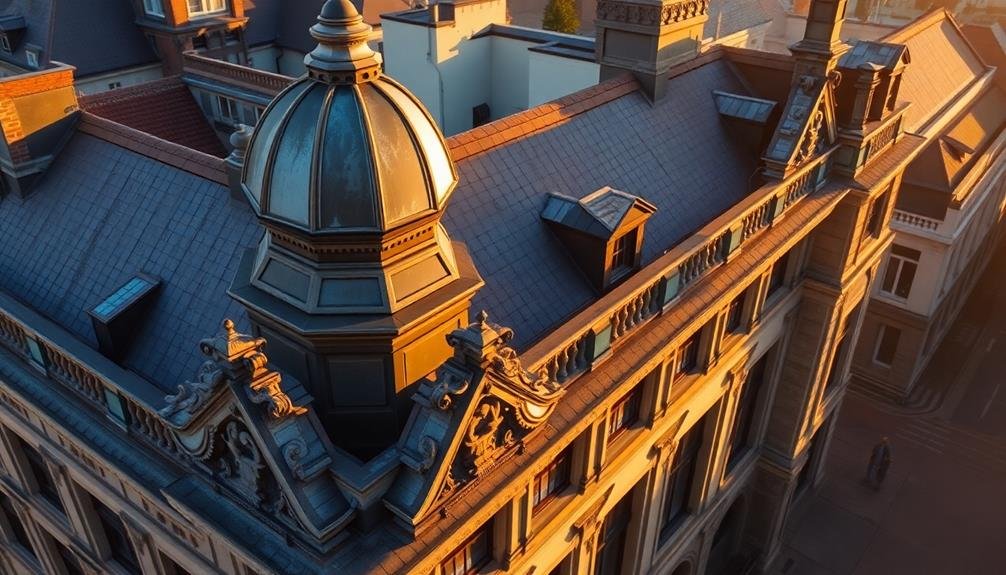
Beyond the reach of passersby, architectural marvels hide in plain sight. You'll discover a wealth of intricate details when you elevate your perspective.
Rooftop gardens, often invisible from street level, burst with life atop urban skyscrapers. These green oases provide biodiversity and combat the heat island effect.
Look closely, and you'll spot ornate cornices adorning building tops. These decorative moldings, crafted by skilled artisans, tell stories of architectural styles and bygone eras.
Aerial views reveal hidden courtyards nestled within city blocks, offering tranquil spaces amidst bustling streets.
You'll notice complex HVAC systems and solar panel arrays that power modern structures. These technological marvels, typically concealed from ground-level view, showcase sustainable design principles.
Unique geometric patterns on rooftops, visible only from above, add artistic flair to utilitarian surfaces.
Don't overlook the intricate stonework and sculptures perched high on facades. These masterpieces, weathered by time, offer glimpses into the building's history and cultural significance.
Urban Planning Revealed Through Drones
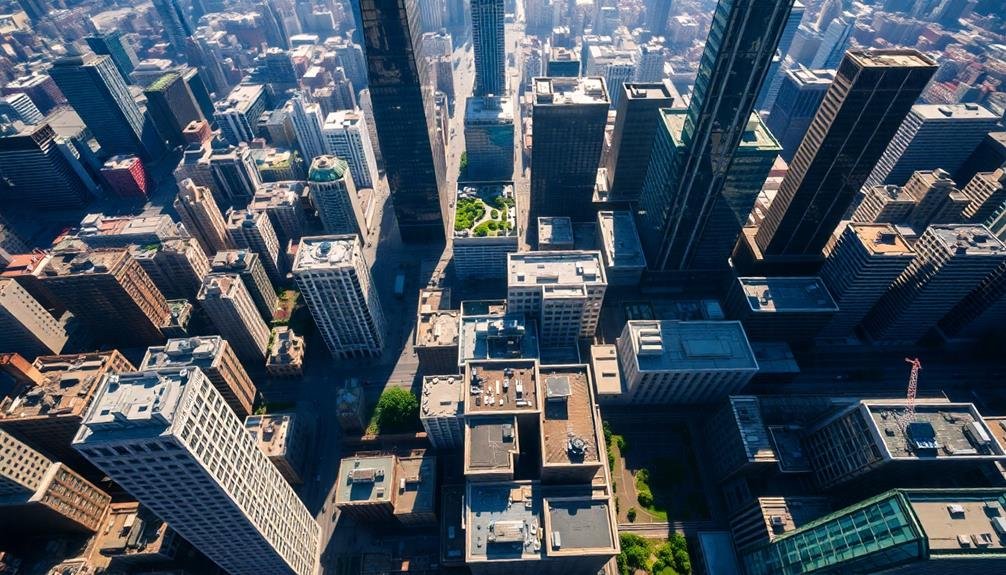
Drones have revolutionized our understanding of urban planning, offering three key insights. First, you'll witness the intricate layout of cities from above, revealing patterns and designs that aren't visible at street level.
Second, you'll see how green spaces are distributed throughout urban areas, highlighting the balance between nature and concrete.
Third, you'll observe traffic flow and infrastructure connections, providing valuable data for city planners.
These aerial perspectives allow you to:
- Identify underdeveloped areas ripe for revitalization
- Assess the effectiveness of current zoning regulations
- Analyze the impact of new construction projects on surrounding neighborhoods
- Monitor urban sprawl and its environmental consequences
You'll gain a deeper appreciation for the complexities of city design as you explore aerial footage. Drones capture the interplay between residential, commercial, and industrial zones, showcasing how cities evolve over time.
They reveal hidden pockets of urban decay and areas of rapid growth, helping you understand the challenges faced by city planners. By utilizing drone technology, you're able to see beyond individual buildings and grasp the larger picture of urban development, fostering a more thorough approach to city planning and management.
Frequently Asked Questions
What Camera Equipment Is Best for Sky-High Architectural Photography?
For sky-high architectural photography, you'll want a high-resolution DSLR or mirrorless camera with a wide-angle lens. Don't forget a sturdy tripod, remote shutter release, and neutral density filters for long exposures. A drone can offer unique perspectives.
How Do Photographers Obtain Permission to Fly Drones in Urban Areas?
You'll need to obtain permits from local authorities to fly drones in urban areas. Contact your city's aviation department, register your drone with the FAA, and complete necessary training. Always check for no-fly zones beforehand.
Are There Safety Concerns When Accessing Rooftops for Aerial Shots?
Yes, there are safety concerns when accessing rooftops for aerial shots. You'll need to watch for unstable surfaces, trip hazards, and edges. Always get permission, use proper safety equipment, and don't take unnecessary risks for a photo.
What Post-Processing Techniques Enhance Architectural Details in Aerial Photographs?
You'll enhance architectural details in aerial shots by adjusting contrast, sharpening edges, and fine-tuning highlights and shadows. Don't forget to straighten lines, correct perspective distortions, and use selective color adjustments to make features pop.
How Do Weather Conditions Affect Sky-High Photography of Buildings?
Weather conditions greatly impact your sky-high building photography. You'll find that clear skies offer crisp details, while overcast days provide softer light. Rain can add reflections, and fog creates mystery. Wind might affect drone stability.
In Summary
You've gained a new perspective on urban landscapes through sky-high photography. You've uncovered hidden gems, from rooftop gardens to forgotten facades. You've seen symmetry in skylines and intricate patterns invisible from the ground. You've witnessed history blend with modernity and geometric shapes emerge from above. Through drones and aerial views, you've revealed the secrets of urban planning and architectural design. Keep looking up – there's always more to discover in the urban jungle.

As educators and advocates for responsible drone use, we’re committed to sharing our knowledge and expertise with aspiring aerial photographers.

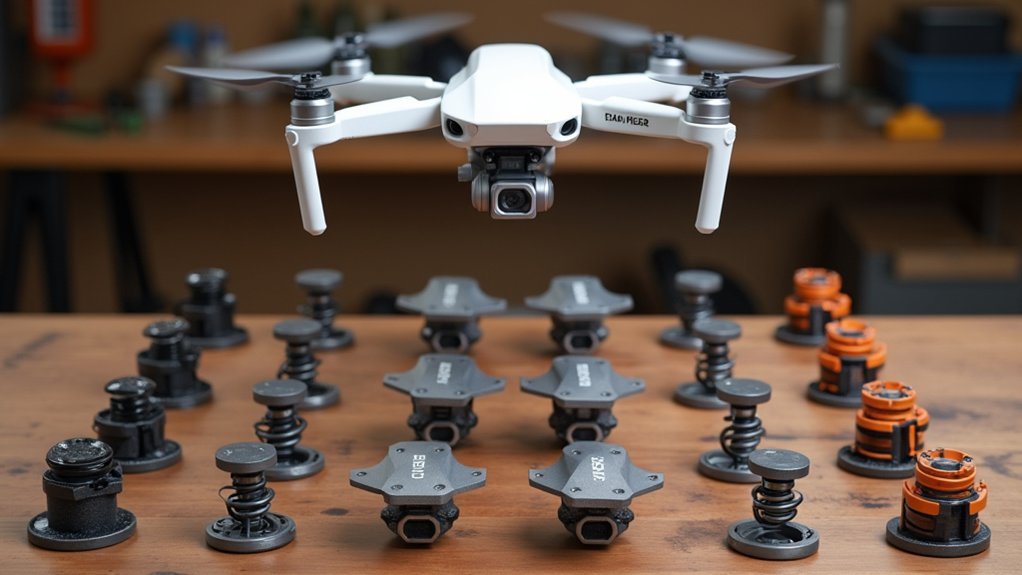
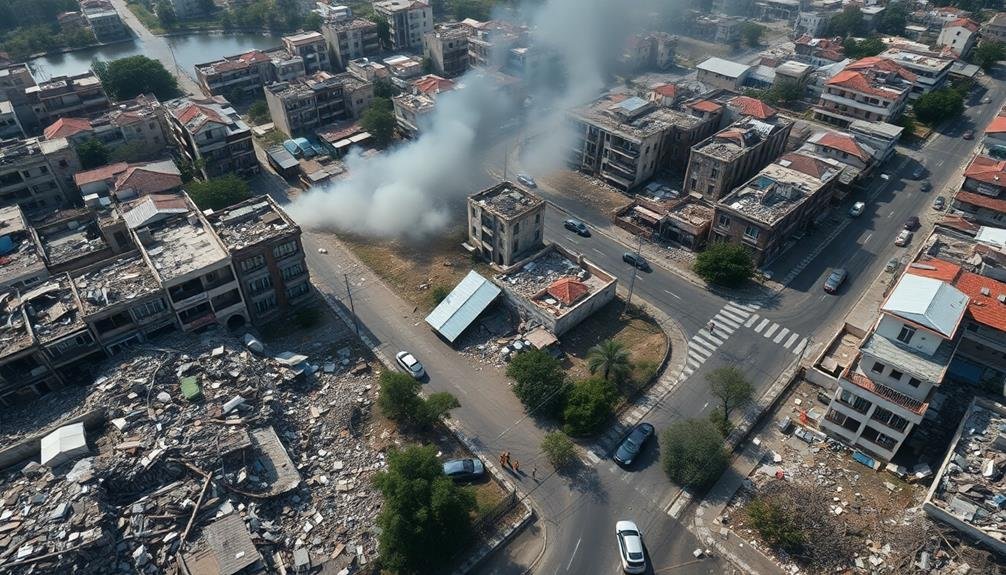
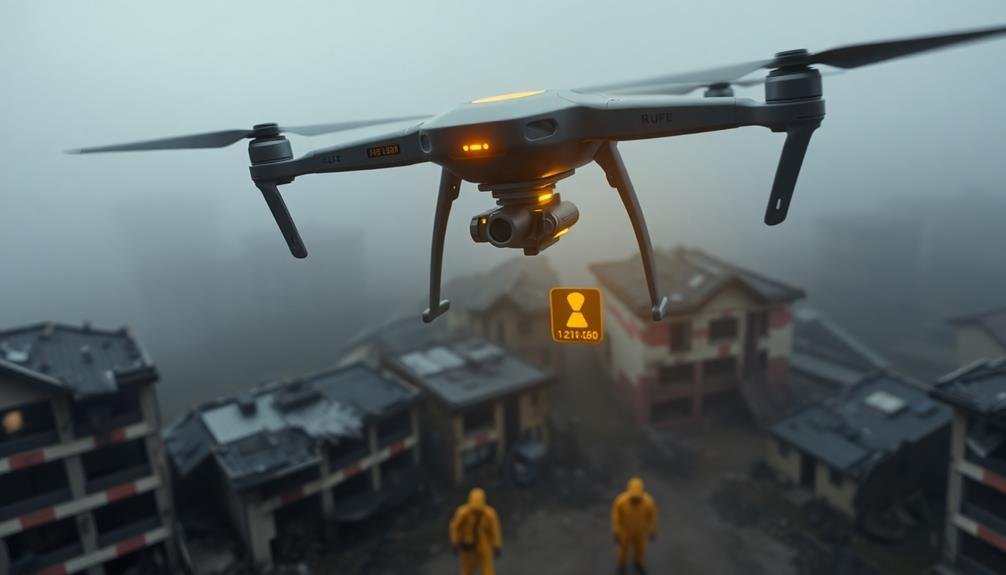
Leave a Reply